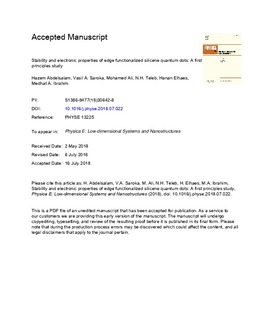| dc.contributor.author | Abdelsalam, H. | |
| dc.contributor.author | Saroka, Vasil | |
| dc.contributor.author | Ali, M. | |
| dc.contributor.author | Teleb, N.H. | |
| dc.contributor.author | Elhaes, H. | |
| dc.contributor.author | Ibrahim, M.A. | |
| dc.date.accessioned | 2019-04-11T07:33:21Z | |
| dc.date.available | 2019-04-11T07:33:21Z | |
| dc.date.created | 2019-01-22T18:01:14Z | |
| dc.date.issued | 2019 | |
| dc.identifier.citation | Physica. E, Low-Dimensional systems and nanostructures. 2019, 108 339-346. | nb_NO |
| dc.identifier.issn | 1386-9477 | |
| dc.identifier.uri | http://hdl.handle.net/11250/2594128 | |
| dc.description.abstract | The stability and electronic properties of hexagonal and triangular silicene quantum dots are investigated under the effect of edge passivation by different elements and molecular groups. The structures experience a considerable alternation in shape depending on the attached elements or groups. The most noticeable alternations occur in zigzag triangular flakes passivated with sulfur and in all the selected flakes when OH groups are attached to their edge atoms. The resulting structure has a spherical shape with a large total dipole moment. All the studied clusters have been proven to be stable by the calculated positive binding energies. A flexible structure transformation from insulator (conductor) to conductor (insulator) is obtained in zigzag hexagonal-H (zigzag triangular-H) and zigzag hexagonal-S (zigzag triangular-OH), respectively. The magnetic properties of the triangular zigzag depend on the parity of the total number of Si atoms such that flakes with an even number of Si atoms will have antiferromagnetic properties while flakes with an odd number of Si atoms can have ferromagnetic or antiferromagnetic properties depending on the attached element or group. Thus, a proper choice of the attached functional groups or elements to silicene flakes allows tailoring of their properties to different application. In particular, hydrogenated or fluorinated flakes are highly interactive with the surrounding and can be used for sensor applications while clusters passivated with S or OH are insensitive to edge defects and have tunable electronic properties that make them promising in semiconductor device applications. | nb_NO |
| dc.description.abstract | Stability and electronic properties of edge functionalized silicene quantum dots: A first principles study | nb_NO |
| dc.language.iso | eng | nb_NO |
| dc.publisher | Elsevier | nb_NO |
| dc.relation.uri | https://doi.org/10.1016/j.physe.2018.07.022 | |
| dc.rights | Attribution-NonCommercial-NoDerivatives 4.0 Internasjonal | * |
| dc.rights.uri | http://creativecommons.org/licenses/by-nc-nd/4.0/deed.no | * |
| dc.subject | Kvantekjemi | nb_NO |
| dc.subject | Quantum chemistry | nb_NO |
| dc.title | Stability and electronic properties of edge functionalized silicene quantum dots: A first principles study | nb_NO |
| dc.type | Journal article | nb_NO |
| dc.type | Peer reviewed | nb_NO |
| dc.description.version | acceptedVersion | nb_NO |
| dc.subject.nsi | VDP::Teoretisk kjemi, kvantekjemi: 444 | nb_NO |
| dc.subject.nsi | VDP::Theoretical chemistry, quantum chemistry: 444 | nb_NO |
| dc.source.pagenumber | 339-346 | nb_NO |
| dc.source.volume | 108 | nb_NO |
| dc.source.journal | Physica. E, Low-Dimensional systems and nanostructures | nb_NO |
| dc.identifier.doi | 10.1016/j.physe.2018.07.022 | |
| dc.identifier.cristin | 1663272 | |
| dc.relation.project | EC/H2020/644076 | nb_NO |
| dc.description.localcode | © 2018. This is the authors’ accepted and refereed manuscript to the article. Locked until 18 July 2020 due to copyright restrictions. This manuscript version is made available under the CC-BY-NC-ND 4.0 license http://creativecommons.org/licenses/by-nc-nd/4.0/ | nb_NO |
| cristin.unitcode | 194,66,20,0 | |
| cristin.unitname | Institutt for fysikk | |
| cristin.ispublished | true | |
| cristin.fulltext | postprint | |
| cristin.qualitycode | 1 | |

